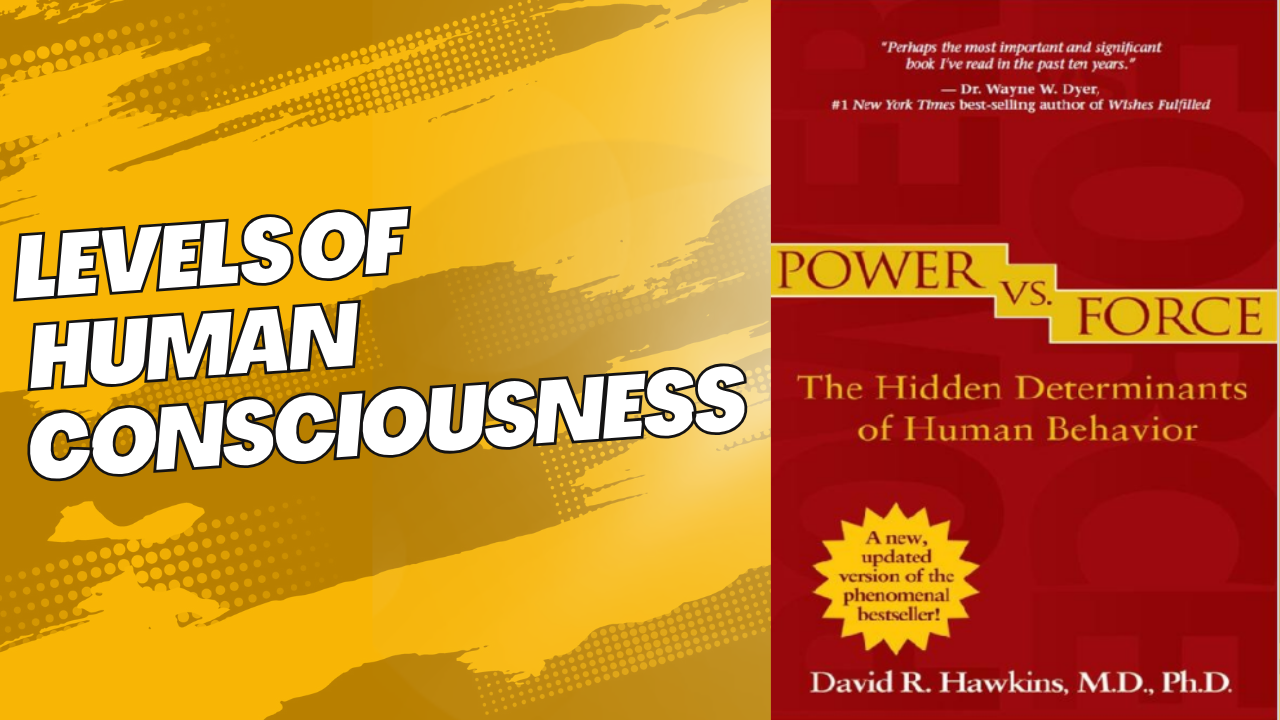
This excerpt from David R. Hawkins’ Power vs. Force explores the relationship between consciousness, energy levels, and human behavior using kinesiology. Hawkins proposes a scale of consciousness, demonstrating how different levels correlate with physical and emotional states, and argues that higher levels of consciousness are associated with power, while lower levels are linked to force. The text examines this framework across various aspects of life, including health, relationships, and societal structures, suggesting that aligning with higher energy fields fosters well-being and positive change. The author utilizes kinesiological muscle testing to support his claims and explores the implications of nonlinear dynamics and attractor fields in understanding consciousness. Finally, the book promotes a shift towards compassion and higher consciousness to improve individual and collective well-being.
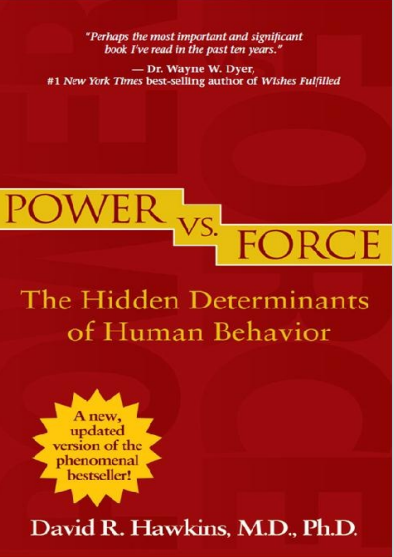
1. What is kinesiology and how is it used in the context of this text?
Kinesiology is the study of muscles and their movements. In this text, it’s used as a method to gauge truth and falsehood by testing muscle strength. Beneficial stimuli or truthful statements result in a strong muscle response (the subject can resist being pushed down), while adverse stimuli or false statements cause a weakened muscle response. This is called behavioral kinesiology when used with non-physical stimuli, like ideas and emotions. This method is presented as a tool to bypass conscious thought and tap into a deeper level of awareness.
2. How does the muscle testing procedure work?
The muscle test requires two people. One person extends their arm horizontally, while the other presses down on their wrist with light pressure, telling them to “resist.” The subject holds a statement or concept in mind during this process. If the statement or concept aligns with truth or positive energy, the arm will remain strong. If it’s false or negative, the arm will weaken. The test isn’t about physical strength, but rather about the body’s response to the statement or concept. The test can be performed by making an O shape with one hand, then attempting to pull the O apart with a finger of the other hand. The O will feel weak or strong depending on the truthfulness of the thought.
3. What is the “Map of Consciousness” and how does it relate to calibration?
The “Map of Consciousness” is a scale from 1 to 1000, created through kinesiological testing, where different emotional states, beliefs, and concepts are calibrated. Lower numbers represent lower, more negative states such as shame, guilt, and fear, while higher numbers denote positive states such as love, reason, joy, and enlightenment. This scale allows for the quantification of consciousness and the appraisal of the innate validity of ideas. Calibrating an item, statement, person or idea, on this scale, involves testing if it calibrates over a certain number (like “over 200”) using muscle testing, until a negative response (weakness) is achieved. You can then refine the calibration by inching upwards to find the exact break point of weakness.
4. What is the distinction between “power” and “force”?
The text distinguishes sharply between power and force. Power is associated with that which supports life, meaning, and principle, and is inherently unifying and attractive. It appeals to our higher nature. Force is divisive, self-serving, and requires justification. It appeals to our lower nature. Force uses manipulation, control, and coercion, while power is self-sustaining and requires no such effort. Power doesn’t need to be used, but is passively expressed through meaning, while force requires an intention to make a thing happen. Power tends to be associated with what uplifts and ennobles, whereas force is associated with what exploits for the gain of an individual or organization.
5. What is the role of “attractor patterns” in our lives?
Attractor patterns are described as energy fields that shape our experiences and the world around us. These can be either high-energy (positive and empowering) or low-energy (negative and destructive). They influence our thoughts, feelings, actions, and perceptions. These attractor patterns, similar to morphogenetic fields, are associated with different emotional and mental states, and the more one aligns with a specific attractor field, the more influence it will have. They also determine the way we perceive the world; different people will react differently to an event because they are aligned with different attractors. They can be a pattern of thought, a belief, a value, or an entire philosophical system.
6. How does the concept of a “database of consciousness” relate to truth and perception?
The text posits a “database of consciousness,” a collective unconscious which contains all information ever available to human consciousness. This database knows “virtually anything the moment it is asked.” According to the text, questions can be answered accurately because the question and answer are created from the same paradigm. It emphasizes that the database functions like an electrostatic condenser, wherein the potential for the answer already exists if the question is asked. Perception is also relative and subjective. People experience the world through the lens of their unique level of consciousness and perception depends on the observer’s level of consciousness, which defines their reality. There isn’t an absolute or singular way of interpreting what is occurring in one’s life.
7. What are the levels of consciousness described, and how do they affect perception?
The text describes a range of consciousness levels from shame to enlightenment. Lower levels (shame, guilt, fear) are characterized by negativity, limitation, and self-defeating behaviors. As one progresses higher (courage, neutrality, acceptance, reason, love), perceptions become more positive, expansive, and compassionate. The levels impact how individuals perceive themselves and the world. A person operating from the lower levels will perceive a “bum” on the street as disgusting, whereas someone operating at a high level will feel compassion. Higher states of awareness have the ability to transcend the dualities of space and time, and the boundaries of identity with a body or mind.
8. What is the path to higher consciousness, and how does this text address spiritual evolution?
The text suggests that spiritual evolution occurs by transcending the limitations of the mind, identifying with the Self as consciousness itself rather than with the ego. Key steps include an intense desire to reach that state, acting with constant forgiveness and gentleness, surrendering personal will, and letting go of thoughts and desires. Spiritual growth is seen as a process of recognizing the illusory nature of the material world and the unconditioned nature of true awareness. This evolution is described as a journey from duality to non-duality, ultimately leading to a state of “Oneness” where there is no separation between self and other, subject and object. This is the state of pure awareness.
Power vs. Force Study Guide
Quiz
Instructions: Answer each question in 2-3 sentences based on the provided source material.
- What is applied kinesiology and how did Dr. George Goodheart use it?
- How does behavioral kinesiology, as developed by Dr. John Diamond, expand on applied kinesiology?
- Explain the basic muscle-testing procedure outlined in the text.
- What is meant by “calibrating” a statement, idea, or ideology, and what is the range of the scale used by Hawkins?
- According to the text, what are the basic steps to reach a state of pure awareness?
- What is the significance of attractor patterns in how individuals and groups behave?
- How do the concepts of “implicate” and “explicate” order, as proposed by physicist David Bohm, relate to the experience of pure awareness?
- How does the text describe the difference between “power” and “force”?
- What is the Map of Consciousness, and how does it relate to different perceptions and behaviors?
- What does the text say about the nature of the “collective unconscious” and the database of consciousness?
Quiz Answer Key
- Applied kinesiology is the study of muscles and their movements, particularly how they are affected by physical stimuli. Dr. Goodheart discovered that beneficial stimuli would increase the strength of certain muscles, while hostile stimuli would weaken them, indicating that the body “knows” what is good or bad for it.
- Behavioral kinesiology expands on applied kinesiology by showing that indicator muscles will also strengthen or weaken in response to positive or negative emotional and intellectual stimuli, in addition to physical stimuli, showing a link between consciousness and muscle response.
- The basic muscle-testing procedure involves a test subject holding one arm out while the tester applies downward pressure to the wrist while the subject resists. The test subject holds a statement or concept in mind, and if it is true, their arm stays strong; if false, the arm weakens.
- Calibrating involves using muscle testing to rate a position, statement, or ideology on a scale of 1 to 1,000, with the point of common weak response determining the calibration. This system allows one to assess the innate validity of any subject.
- The basic steps to reaching pure awareness involve an intense desire to reach that state and practicing constant forgiveness and gentleness. One must be compassionate towards everything, willing to surrender personal will, and letting go of thoughts, feelings, longings, and deeds to God, leading to a silent mind.
- Attractor patterns are predominant patterns of energy that determine how individuals and groups perceive data and the world, as well as influence behavior; they can be calibrated to understand human motivations and experiences.
- Bohm’s theory of an implicate (“enfolded”) and explicate (“unfolded”) order corresponds to the idea that there is a source beyond both realms. This is like the state of pure awareness experienced by sages, suggesting an underlying order to reality that transcends physical manifestations.
- “Power,” as described in the text, comes from meaning, motive, and principle, supporting the significance of life, and uplifts, dignifies, and ennobles. “Force,” on the other hand, is associated with what exploits life for individual or organizational gain, and it is divisive, limited, and self-serving.
- The Map of Consciousness is a scale used to calibrate the energy levels of thoughts, emotions, and concepts, with lower levels associated with negative emotions and higher levels with positive states. Different perceptions and behaviors depend on the level of consciousness from which one views the world.
- The collective unconscious is a vast database of shared human experiences characterized by powerful, universal organizing patterns. It is a reservoir of information, capable of tapping into all that has been experienced at any time, enabling immediate access to knowledge.
Essay Questions
Instructions: Address each question in a well-structured essay, drawing on concepts and ideas from the provided source material.
- Discuss how the principles of applied and behavioral kinesiology reveal the connection between physical and emotional/intellectual states, and how this might alter our understanding of diagnosis and treatment in various fields.
- Analyze the role of attractor patterns in shaping individual and collective behaviors, drawing specific examples from the text and elaborating on how understanding these patterns can lead to personal and social transformation.
- Explain the concept of “power” versus “force,” as described in the source, and provide examples of how these concepts have been manifested in historical events and individual actions.
- Elaborate on the Map of Consciousness presented in the text, and detail how an understanding of these levels can influence personal development, as well as the perception of reality, and interpersonal relations.
- Explore the concept of the collective unconscious, as presented by Jung, and the database of consciousness, as explained by Hawkins. Discuss the implications of the nature of the universe as holographic for human understanding and experience.
Glossary of Key Terms
- Applied Kinesiology: The study of muscles and their movements, particularly how they respond to physical stimuli, used as a means of gaining insights into a person’s physical condition and reactions.
- Behavioral Kinesiology: An expanded form of kinesiology that considers emotional and intellectual stimuli along with physical stimuli to determine the body’s response, suggesting a link between consciousness and physical strength.
- Calibration: The process of using muscle testing to rate a statement, idea, or ideology on a scale (1-1,000 in this text) to determine its relative truth or validity.
- Map of Consciousness: A scale used to assess the energy levels of thoughts, emotions, and beliefs, ranging from low-frequency negative states to high-frequency positive states like love and enlightenment.
- Attractor Patterns: Predominant patterns of energy that influence how individuals and groups behave and interpret information, described as an organizing force of consciousness.
- Implicate Order: A term from physicist David Bohm describing the enfolded, invisible, and underlying reality; this represents a realm of potentiality from which the manifest universe emerges.
- Explicate Order: A term from physicist David Bohm describing the unfolded, manifest, visible universe; the realm of forms and observable phenomena.
- Power: An energy aligned with meaning, motive, and principle that supports the significance of life, and uplifts, dignifies, and ennobles; it unifies.
- Force: Energy associated with what exploits life for the gain of an individual or an organization; it is divisive, limited, and self-serving.
- Collective Unconscious: A concept developed by Carl Jung representing the subconscious pool of shared human experiences and archetypal patterns.
- Database of Consciousness: An infinite reservoir of all information ever available to human consciousness, capable of “knowing” anything the moment it is asked.
- Holographic Universe: The concept that the universe is structured like a hologram, where each part contains the information of the whole and the whole exists in each part.
- Nonduality: A state of being in which there is no separation between subject and object, observer and observed, and all is experienced as One.
- Thymus Thump: A technique involving rhythmic pounding on the thymus gland (behind the breastbone) to quickly restore balance and improve the accuracy of muscle testing.
- Entrainment: The process of how energy fields are influenced by other, stronger energy fields. Higher attractor fields have an anabolic or growth enhancing effect while lower attractor fields have a catabolic or destructive effect.
- Right Brain: A way of processing information that is nonlinear, intuitive, and holistic, focused on patterns and relationships; it enables understanding of meaning, significance, and inference.
- Left Brain: A way of processing information that is linear and logical, processing data in a sequence, and is comparable to the way a digital computer works.
- M-Fields: Morphogenetic fields, which are equivalent to attractor patterns.
- Stochastic: Random, unpredictable, nonlinear, chaotic.
- Strange Attractor: A pattern within a phase space. The pattern is traced by the dynamic points in time of a dynamic system.
- Perception: The way an individual or group interprets sensory input, highly influenced by attractor patterns; it can be said to “create” their world and varies based on the level of consciousness.
- Paradigm: A framework through which an individual understands reality and that inherently predicts one’s perception of reality.
- Phase Space: A map that condenses time-space data into a pattern in multiple dimensions.
- Scientific: The method of inquiry into nature specifically designed to derive predictable laws of physical properties.
- Universe: There may be an infinite number of dimensions to our universe. The space between planetary bodies isn’t empty, but filled with a sea of energy.




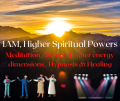

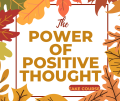
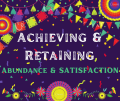
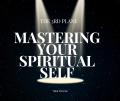

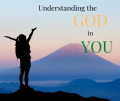
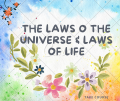










0 responses on "Levels of Human Consciousness"